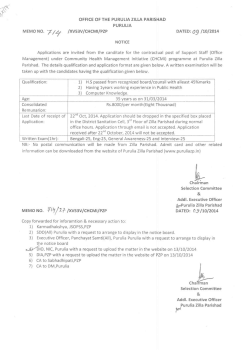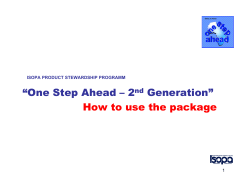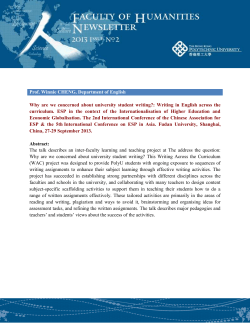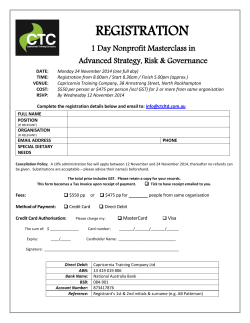
Using Employee Profiling To Win The War For Talent Presented By David Reynolds
Using Employee Profiling To Win The War For Talent Presented By David Reynolds Executive General Manager – Consulting Chandler Macleod Australasia Session Objectives • • • • Define Employee Profiling Explain its growing popularity and use Outline the different Employee Profiling options available Demonstrate how organisations can use Employee Profiling to help win the war for talent Who is Chandler Macleod? • • • • • • Australia’s leading firm of people consultants Established in 1959 Employ over 700 people across 70 offices in Australasia Specialise in people attraction, assessment, development and impact initiatives Focus on helping our client partners maximise people performance and manage risk Profile 8000+ employees each year ‘Management Speak’ “We expected that Good to Great leaders start out by setting a new vision and strategy. We found out instead that they first got the right people on the bus, the wrong people off the bus, the right people in the right seats – and then they figured out where to drive it”. Good to Great – Jim Collins What is Employee Profiling? Understanding the individual Understanding the organisation General Employment Trends (Year to April 2006) • Employment increased to 10,079,800 • Unemployment decreased to 543,100 • Unemployment rate stable at 5.1% Employment Trends Unemployment Trends National Employment Forecast May 2006 Quarter • • • • Australian labour market growth will slow Skills shortage and high demand = rising wages WA skills shortage now the worst on record State and Federal Governments issuing infrastructure projects warnings • Queensland and Western Australia will account for almost half of all new jobs created What Does This Mean for Employers? • In short “War for Talent”! • Skills shortages, coupled with high demand, are driving wages higher • Employers and recruitment firms are finding it increasingly difficult to find and retain talented employees • Suitable applications to recruitment advertising continues to fall • Newspaper “Positions Vacant” adverts are attracting as little as 5-10 responses • Your competitors are targeting your talented employees, right now! Did You Know That… • Replacing an employee in the first year costs up to 3 times their salary • Selecting a top performer can mean significant impact on your people investment Average Salary Increase in Output Unskilled $40k 19% $7,600 Skilled $70k 32% $22,400 Management $100k 48% $48,000 Job Level Increase in ROI Did You Know That… TOP THIRD PERFORMERS MAKE YOU MONEY MIDDLE THIRD PERFORMERS MAINTAIN STATUS QUO BOTTOM THIRD PERFORMERS LOSE YOU MONEY Did You Know That… • When managers were asked: Q:”If you knew at the time of hire what you now know, would you rehire? A: 32% of current staff would not be rehired! The Cost of Getting it Wrong • Recruitment is not a perfect science…in the people business, mistakes can occur • The cost of hiring the wrong person includes: – – – – – – – Salary cost of payout/notice period Lost productivity (of the hired person and co-worker overload) Lost productivity (morale drop of co-workers and teams) Re-hire costs Learning curve ‘productivity lag’ of new starter Re-training costs Loss of intellectual capital Common Problems in Selection • • • • • • • • Important information is missed Applicant data is misinterpreted Biases and stereotypes affect judgement Decisions are made too quickly Too much reliance on interview Pressure to fill positions affects judgement Interviewer’s hiring decisions not systematic Availability of candidates affect judgement The Case for Employee Profiling Correct Decision CORRECT DECISION Suitable Candidate Unsuitable Candidate Incorrect Decision INCORRECT DECISION The person “looks right and is right” The person “looks wrong and is right” - obvious hire, can demand higher salary - missed opportunity The person “looks wrong and is wrong” The person “looks right and is wrong” - risk avoided - management problem Understanding the Person Abilities Cognitive or intellectual abilities. Some are learned or formalised, others are more innate. Knowledge, Skills and Experience Temperament This information is gathered through standard recruitment steps Behaviour in a particular situation and the use of personal resources Based on habits, feelings, attitudes and emotions Interests Effects both performance and job satisfaction Standard Recruitment CM Assessment The Formula For Behaviour BEHAVIOUR Performance Satisfaction = fn Can Do ( PERSON X ENVIRONMENT Skills Knowledge Experience Co-operative Working structures Ability Aptitude Performance Management Systems Interests Organisational Adaptiveness Temperament Power/Politics/ Culture Employee Engagement Calibre of Leadership Want to How to Motivation ) “Management Speak” “We expected that Good to Great leaders start out by setting a new vision and strategy. We found instead that they first got the right people on the bus, the wrong people off the bus, the right people in the right seats - and then they figured out where to drive it.” Good to Great, Jim Collins “Management Speak” % Importance of Success Factors Tom Peters Strategy Systems People Passion 15 20 35 30 www.tompeters.com/slides/uploaded/Talent50_101305.ppt Performance & Productivity Jim’s “Right People”… Tom’s “Passionate People”… Performance & Productivity: the constant effort to increase the number of stars, get the best from the core and move low performers as fast as you can The Value of Employee Profiling Cognitive Skills Competency Integrity Initiative Achievement Drive Interview (Unstructured) Interview (Behavioural) Reference Check (structured) Work Sampling Narrow Personality Broad Personality Most useful Ability Testing IQ Assessment Technical Least useful 0.6 0.5 0.4 0.3 0.2 0.1 Correlation Coefficient Techniques to Measure Behaviour Predictability Ratings 0.7 0 tC s ) al ur ur ) re ai ed nn ct io s st s io tre av en eh st t ru st Te Te ns ue y ilit e (B en s m w pl (u Q Ab m e t iv Sa ie ss rv se te As In k or ni s s it y w ce al a on rv ie en at rs og W C Pe te er ef od Bi R In s Selection Method Best Fit Concept BEHAVIOUR Performance = fn Can Do ( PERSON Skills Knowledge Experience Ability Aptitude Satisfaction X ENVIRONMENT ) •Behavioural Interviews •Work Sample tests •Cognitive Ability appraisal Want to •Behavioural Interviews Interests How to •Personality questionnaires •Reference checking Temperament Motivation Employee Engagement The Use of Employee Profiling • Organisations are increasingly using psychometric assessment to select the right person for the right job: – – – – – Do they have the skills and abilities to do the job? Are they motivated to do the job? Will they be motivated to stay with the organisation? Will they fit within the culture? Will they do the right thing by the organisation? Testing for Skills and Abilities • Specialist tests – – – – – – – – Verbal and Numerical Reasoning Mechanical Reasoning Understanding Instructions Visual Checking Fault Finding Spatial Checking Technical Understanding Abstract Reasoning • Work simulations- including role plays, in-tray exercises, presentations Assessment for ‘Fit’ • Use a personality scale to assess what makes the person tick: – Teamwork – Perseverance – Commitment – Results focus – Work ethic – Integrity – Safety focus – Motivation for the role – Focus on detail – How to manage the person – Ability to work autonomously – How to keep them motivated – Ability to take the initiative Employee Profiling Innvovations CM developed the ESP, a leading edge system that provides information on the strenghts and weaknessess of an individual in relation to different roles in the organisation The ESP provides a report that includes: shortlist of jobs that best fit their soft skills including a comprehensive job fit report job fit reports of employer specific jobs and local skill shortages Training & development suggestions Understanding the job fit of a candidate and their potential for different roles in your organisation How ESP works Suitability of candidate for other roles (across and higher up the organisational structure) Suitability of candidate for a particular role in their organisation ? Provision of management and training advice in case there is a gap between job requirements and the candidate’s profile Employability How ESP works Employability Skills Initiative & Enterprise Team Work Problem Solving SelfManagement Planning & Organising Communication Learning Technology Competencies Speaking Effectively Assertiveness Persuasiveness Networking Empathy Understanding Verbal Instructions Information Sharing Customer Focus Behaviours Behaviour A Behaviour B Behaviour C Behaviour D The ability to listen and understand spoken instructions How ESP works Pre-tasks • Consent • Moving Through the Tasks • A Short Practice Task • Questionnaire Entry Level - Skilled • Humm Wadsworth Temperament Scale • Working with Numbers (SHL NWP2) • Understanding Instructions (SHL VWP1) • Reasoning (SHL DC3.1R ) Professional • Humm Wadsworth Temperament Scale • Numerical Reasoning (SHL NMG2004) • Reasoning (SHL DC3.1R) • Verbal Reasoning (SHL VMG2004) Profiling Against Multiple Roles Innovation Features • Evaluation of all staff possible • Against universally-accepted Employability Skills • Produces Degree of Fit to Role report, not percentile numbers • Online, on-site, on demand • Instant access to all reports • Average assessment time for both entry and professional level assessments reduced by 40% • Assess once – apply each time a decision is required against any role Questions ?…
© Copyright 2025















